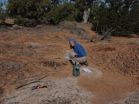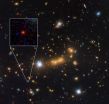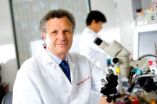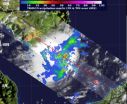(Press-News.org) Some arid lands in the American West degraded by military exercises that date back to General George Patton's Word War II maneuvers in the Mojave Desert should get a boost from an innovative research project led by the University of Colorado Boulder.
Headed up by CU-Boulder Assistant Professor Nichole Barger, the research team is focused on developing methods to restore biological soil crusts -- microbial communities primarily concentrated on soil surfaces critical to decreasing erosion and increasing water retention and soil fertility. Such biological soil crusts, known as "biocrusts," can cover up to 70 percent of the ground in some arid ecosystems and are dominated by cyanobacteria, lichens, mosses, fungi and bacteria, she said.
The project is aimed at restoring fragile habitats in desert areas that have been affected by the movement of U.S. military vehicles, including tanks, as well as high foot traffic, said Barger, a faculty member in CU-Boulder's ecology and environmental biology department. The team has two U.S. Department of Defense study sites -- Fort Bliss, which straddles southern Texas and New Mexico and is located in a hot desert environment, and the Dugway Proving Ground in northwest Utah, seated in a cool desert environment.
"Biocrusts often are associated with increased soil nutrients and water retention, but their most important task is to stabilize soil surfaces against wind and water erosion," Barger said. "While most biocrusts are relatively resilient to wind and water erosion, they are highly susceptible to compressional forces like those generated by foot and vehicle traffic associated with ground-based military activities."
At military installations like Fort Bliss, the Dugway Proving Ground and in the California/Arizona Maneuver Area in the Mojave Desert used by Patton's troops, scars of past military activity still are evident, said Barger. "You can go to these places and see that the biocrusts in the old tank tracks, for example, are completely different than nearby biocrusts undisturbed by military activity."
The project is being funded by a five-year, $2.3 million grant from the Strategic Environmental Research and Development Program, the U.S. Department of Defense environmental science and technology program that partners with the U.S. Department of Energy and the Environmental Protection Agency. The research team also includes Jayne Belnap, Michael Duniway and Sasha Reed from the U.S. Geological Survey's Biological Resources Division in Moab, Utah and Ferran Garcia-Pichel of Arizona State University in Tempe.
The first step of the program will be to grow biocrusts in laboratories at ASU, said Barger. "Our approach will be to expose laboratory biocrusts over time to a physiological 'boot camp' that includes increasing stressors like heat, light and dryness," she said. "By doing that, we believe the biocrusts we eventually transplant into the study areas will have a higher probability of survival."
The lab-grown biocrust products will be dried, bagged and transported to field test sites at each respective military installation and sprinkled on soil surfaces, said Barger.
Once in the field, the stress-adapted biocrusts developed in the lab nurseries for both hot desert and cool desert environments will be combined with other soil stabilization strategies, she said. The team, for example, will also experiment with adding polyacrylamide -- a soil-stabilizing compound shown to increase soil porosity and reduce erosion, compaction, dustiness and water run-off -- to the mix.
The researchers will evaluate the effectiveness of such soil "inoculations" and determine the optimum dosage for the test sites. Following the assisted recovery of the local biocrusts at Fort Bliss and the Dugway Proving Ground, the team will begin a series of seeding trials to develop strategies for native plant re-establishment, Barger said.
The last step of the project will involve a series of rainfall simulations and wind tunnel experiments combined with broad-scale soil erosion modeling to evaluate the influence of biocrust and native plant restoration in terms of precipitation and soil erosion.
While DOD military installations cover nearly 30 million acres -- 70 percent of which are located in arid regions of the West -- Barger said the research also could aid in the effective management of other federal lands. "We think our work on biocrusts also will be of interest to land managers at agencies like the Bureau of Land Management and the U.S. Forest Service," Barger said.
The adaptation of biocrusts to extreme environments likely will come into play even more as climate change continues to heat and dry the West, she said. "We expect the drought in the Southwest to intensify as a result of climate change, and this project should tell us more about how adaptive these biocrusts are under shifting environmental conditions."
The research project also has health implications, said Barger, since the disturbance of biocrusts can trigger the release of significant amounts of atmospheric dust, a dominant pollutant in some desert metropolitan areas. "There is a broad societal interest in stabilizing dryland soils in order to protect not only the functioning of local ecosystems but also human populations that reside in surrounding communities."
"In terms of tackling an important environmental issue, this is by far the most exciting research project that I have been involved in," said Barger, who has worked in Hawaii, Central America, South America, China and South Africa.
INFORMATION:
Contact:
Nichole Barger, 303-492-8239
Nichole.Barger@colorado.edu
Jim Scott, CU media relations, 303-492-3114
Jim.Scott@colorado.edu
Degraded military lands to get ecological boost from CU-led effort
Team aims to transplant biological soil crusts in places where desert landscape has been damaged by tank and foot traffic
2012-11-16
ELSE PRESS RELEASES FROM THIS DATE:
Hubble helps find candidate for most distant object in the universe yet observed
2012-11-16
By combining the power of the NASA/ESA Hubble Space Telescope, NASA's Spitzer Space Telescope and one of nature's zoom lenses, astronomers have found what is probably the most distant galaxy yet seen in the Universe. The object offers a peek back into a time when the Universe was only 3 percent of its present age of 13.7 billion years.
We see the newly discovered galaxy, named MACS0647-JD, as it was 420 million years after the Big Bang. Its light has travelled for 13.3 billion years to reach Earth, which corresponds to a redshift of approximately 11 [1].
This is the ...
Quick, high-volume test offers fast track in search for Alzheimer's drugs
2012-11-16
An efficient, high-volume technique for testing potential drug treatments for Alzheimer's disease uncovered an organic compound that restored motor function and longevity to fruit flies with the disease, according to new research that could help put the search for an effective Alzheimer's drug on a faster track.
Princeton University researchers report in the Journal of Biological Chemistry that they discovered an organic compound that prevented the formation of protein clumps, or aggregates, found on human brain cells afflicted by Alzheimer's disease. The researchers ...
Neurons made from stem cells drive brain activity after transplantation in laboratory model
2012-11-16
LA JOLLA, Calif., November 15, 2012 – Researchers and patients look forward to the day when stem cells might be used to replace dying brain cells in Alzheimer's disease and other neurodegenerative conditions. Scientists are currently able to make neurons and other brain cells from stem cells, but getting these neurons to properly function when transplanted to the host has proven to be more difficult. Now, researchers at Sanford-Burnham Medical Research Institute (Sanford-Burnham) have found a way to stimulate stem cell-derived neurons to direct cognitive function after ...
Barrow scientists discover ways to optimize light sources for vision
2012-11-16
(Phoenix, AZ Nov. 15, 2012) -- Vision researchers at Barrow Neurological Institute have made a groundbreaking discovery into the optimization of light sources to human vision. By tuning lighting devices to work more efficiently with the human brain the researchers believe billions of dollars in energy costs could be saved.
The research was conducted by Stephen Macknik, PhD, of Barrow's Laboratory of Behavioral Neurophysiology, and Susana Martinez-Conde, PhD, of Barrow's Laboratory of Visual Neuroscience. The study is published Proceedings of the National Academy ...
Researchers outline effective strategies to prevent teen depression and suicide
2012-11-16
Untreated depression is one of the leading causes of teen suicide, and signs of depression can also be a warning that a teen is contemplating suicide. In an article published this week in the quarterly journal, The Prevention Researcher, University of Cincinnati researchers are describing how positive connections can help offset these tragedies.
In the current issue, titled, "Teen Depression," UC researchers Keith King, a professor of health promotion, and Rebecca Vidourek, an assistant professor of health promotion, report that depression and suicide are "intricately ...
New injectable gels toughen up after entering the body
2012-11-16
CAMBRIDGE, MA -- Gels that can be injected into the body, carrying drugs or cells that regenerate damaged tissue, hold promise for treating many types of disease, including cancer. However, these injectable gels don't always maintain their solid structure once inside the body.
MIT chemical engineers have now designed an injectable gel that responds to the body's high temperature by forming a reinforcing network that makes the gel much more durable, allowing it to function over a longer period of time.
The research team, led by Bradley Olsen, an assistant professor of ...
Arginine and proline enriched diet may speed wound healing in diabetes
2012-11-16
BETHESDA, Md. (Nov. 15, 2012)—Chronic wounds such as foot ulcers are a common problem for diabetics and are the cause of more than 80 percent of the lower leg amputations in these patients. There is currently no effective way to improve healing of these types of wounds, but new research offers hope.
French researchers found that diabetic rats on a high protein diet with arginine and proline—specific molecules found in protein—showed better wound healing over rats fed either standard or high protein food without arginine and proline supplementation.
The article is entitled ...
Scientists improve dating of early human settlement
2012-11-16
A Simon Fraser University archaeologist and his colleagues at the University of Queensland in Australia have significantly narrowed down the time frame during which the last major chapter in human colonization, the Polynesian triangle, occurred.
SFU professor David Burley, Marshall Weisler and Jian-Xin Zhao argue the first boats arrived between 880 and 896 BC. The 16-year window is far smaller than the previous radiocarbon-dated estimate of 178 years between 2,789 and 2,947 years ago.
Burley, the lead author, and his colleagues have recently had their claims published ...
NASA catches small area of heavy rain in fading Tropical Depression 25W
2012-11-16
Tropical Depression 25W was raining on southern Vietnam on Nov. 14 when NASA's TRMM satellite passed overhead and measured rainfall rates within the storm. TRMM noticed that the heaviest rainfall was limited to a small area and was located over open waters.
NASA's TRMM or Tropical Rainfall Measuring Mission satellite was launched in 1997, and can read that rate at which rain falls in storms on Earth from its orbit in space. NASA's TRMM satellite flew over Tropical Depression 25W on Nov. 14 at 0133 UTC and captured rainfall rate data. The TRMM data showed a small area ...
Most-distant galaxy candidate found
2012-11-16
Pasadena, CA— A team of astronomers including Carnegie's Daniel Kelson have set a new distance record for finding the farthest galaxy yet seen in the universe. By combining the power of NASA's Hubble Space Telescope, Spitzer Space Telescope, and one of nature's own natural "zoom lenses" in space, they found a galaxy whose light traveled 13.3 billion years to reach Earth. Their work will be published in The Astrophysical Journal.
The diminutive blob--only a tiny fraction of the size of our Milky Way galaxy--offers a peek back in time to when the universe was 3 percent ...
LAST 30 PRESS RELEASES:
Numbers in our sights affect how we perceive space
SIMJ announces global collaborative book project in commemoration of its 75th anniversary
Air pollution exposure and birth weight
Obstructive sleep apnea risk and mental health conditions among older adults
How talking slows eye movements behind the wheel
The Ceramic Society of Japan’s Oxoate Ceramics Research Association launches new international book project
Heart-brain connection: international study reveals the role of the vagus nerve in keeping the heart young
Researchers identify Rb1 as a predictive biomarker for a new therapeutic strategy in some breast cancers
Survey reveals ethical gaps slowing AI adoption in pediatric surgery
Stimulant ADHD medications work differently than thought
AI overestimates how smart people are, according to HSE economists
HSE researchers create genome-wide map of quadruplexes
Scientists boost cell "powerhouses" to burn more calories
Automatic label checking: The missing step in making reliable medical AI
Low daily alcohol intake linked to 50% heightened mouth cancer risk in India
American Meteorological Society announces Rick Spinrad as 2026 President-Elect
Biomass-based carbon capture spotlighted in newly released global climate webinar recording
Illuminating invisible nano pollutants: advanced bioimaging tracks the full journey of emerging nanoscale contaminants in living systems
How does age affect recovery from spinal cord injury?
Novel AI tool offers prognosis for patients with head and neck cancer
Fathers’ microplastic exposure tied to their children’s metabolic problems
Research validates laboratory model for studying high-grade serous ovarian cancer
SIR 2026 delivers transformative breakthroughs in minimally invasive medicine to improve patient care
Stem Cell Reports most downloaded papers of 2025 highlight the breadth and impact of stem cell research
Oxford-led study estimates NHS spends around 3% of its primary and secondary care budget on the health impacts of heat and cold in England
A researcher’s long quest leads to a smart composite breakthrough
Urban wild bees act as “microbial sensors” of city health.
New study finds where you live affects recovery after a hip fracture
Forecasting the impact of fully automated vehicle adoption on US road traffic injuries
Alcohol-related hospitalizations from 2016 to 2022
[Press-News.org] Degraded military lands to get ecological boost from CU-led effortTeam aims to transplant biological soil crusts in places where desert landscape has been damaged by tank and foot traffic




